Effect of Tool Offset on the Microstructure and Properties of AA6061/AZ31B Friction Stir Welding Joints
Abstract
1. Introduction
2. Experimental Procedures
3. Results and Discussion
3.1. Macromorphologies of the Joints
3.2. Microstructure of the Welds
3.3. Microhardness of the Joints
3.4. Tensile Properties and Fracture Analysis
4. Conclusions
Author Contributions
Funding
Acknowledgments
Conflicts of Interest
References
- Liu, L.; Ren, D.; Liu, F. A Review of Dissimilar Welding Techniques for Magnesium Alloys to Aluminum Alloys. Materials 2014, 7, 3735–3757. [Google Scholar] [CrossRef] [PubMed]
- Wan, L.; Huang, Y. Friction stir welding of dissimilar aluminum alloys and steels: A review. Int. J. Adv. Manuf. Technol. 2018, 99, 1781–1811. [Google Scholar] [CrossRef]
- Zhou, L.; Li, G.H.; Liu, C.L.; Wang, J.; Huang, Y.X.; Feng, J.C.; Meng, F.X. Effect of rotation speed on microstructure and mechanical properties of self-reacting friction stir welded Al-Mg-Si alloy. Int. J. Adv. Manuf. Technol. 2016, 89, 3509–3516. [Google Scholar] [CrossRef]
- Ramulu, P.J.; Narayanan, R.; Kailas, S.V.; Reddy, J. Internal defect and process parameter analysis during friction stir welding of Al 6061 sheets. Int. J. Adv. Manuf. Technol. 2012, 65, 1515–1528. [Google Scholar] [CrossRef]
- Li, Y.; Qin, F.; Liu, C.; Zhisheng, W. A Review: Effect of Friction Stir Welding on Microstructure and Mechanical Properties of Magnesium Alloys. Metals 2017, 7, 524. [Google Scholar] [CrossRef]
- Shah, L.H.A.; Othman, N.H.; Gerlich, A. Review of research progress on aluminium–magnesium dissimilar friction stir welding. Sci. Technol. Weld. Join. 2017, 23, 256–270. [Google Scholar] [CrossRef]
- Shi, H.; Chen, K.; Liang, Z.; Dong, F.; Yu, T.; Dong, X.; Zhang, L.; Shan, A. Intermetallic Compounds in the Banded Structure and Their Effect on Mechanical Properties of Al/Mg Dissimilar Friction Stir Welding Joints. J. Mater. Sci. Technol. 2017, 33, 359–366. [Google Scholar] [CrossRef]
- Wang, T.; Zou, Y.; Matsuda, K. Micro-structure and micro-textural studies of friction stir welded AA6061-T6 subjected to different rotation speeds. Mater. Des. 2016, 90, 13–21. [Google Scholar] [CrossRef]
- Nourani, M.; Milani, A.S.; Yannacopoulos, S. On experimental optimization of friction stir welding of aluminum 6061: Understanding processing-microstructure-property relations. Int. J. Adv. Manuf. Technol. 2015, 79, 1425–1441. [Google Scholar] [CrossRef]
- Fu, B.; Qin, G.; Li, F.; Meng, X.; Zhang, J.; Wu, C. Friction stir welding process of dissimilar metals of 6061-T6 aluminum alloy to AZ31B magnesium alloy. J. Mater. Process. Technol. 2015, 218, 38–47. [Google Scholar] [CrossRef]
- Verma, J.; Taiwade, R.V.; Reddy, C.; Khatirkar, R.K. Effect of Friction Stir Welding Process Parameters on Mg-AZ31B/Al-AA6061 Joints. Mater. Manuf. Process. 2017, 33, 308–314. [Google Scholar] [CrossRef]
- Sato, Y.S.; Park, S.H.C.; Michiuchi, M.; Kokawa, H. Constitutional liquation during dissimilar friction stir welding of Al and Mg alloys. Scr. Mater. 2004, 50, 1233–1236. [Google Scholar] [CrossRef]
- Esparza, J.A.; Davis, W.C.; Trillo, E.A.; Murr, L.E. Friction stir welding of magnesium alloy AZ31B to aluminum alloy 5083. Sci. Technol. Weld. Join. 2003, 8, 462–464. [Google Scholar]
- Buffa, G.; Baffari, D.; Di Caro, A.; Fratini, L. Friction stir welding of dissimilar aluminium–magnesium joints: Sheet mutual position effects. Sci. Technol. Weld. Join. 2015, 20, 271–279. [Google Scholar] [CrossRef]
- Yamamoto, N.; Liao, J.; Watanabe, S.; Nakata, K. Effect of Intermetallic Compound Layer on Tensile Strength of Dissimilar Friction-Stir Weld of a High Strength Mg Alloy and Al Alloy. Mater. Trans. 2009, 50, 2833–2838. [Google Scholar] [CrossRef]
- Firouzdor, V.; Kou, S. Al-to-Mg Friction Stir Welding: Effect of Material Position, Travel Speed, and Rotation Speed. Met. Mater. Trans. A 2010, 41, 2914–2935. [Google Scholar] [CrossRef]
- Kumar, K.; Kailas, S.V. Positional dependence of material flow in friction stir welding: Analysis of joint line remnant and its relevance to dissimilar metal welding. Sci. Technol. Weld. Join. 2010, 15, 305–311. [Google Scholar] [CrossRef]
- Azizieh, M.; Alavijeh, A.S.; Abbasi, M.; Balak, Z.; Kim, H. Mechanical properties and microstructural evaluation of AA1100 to AZ31 dissimilar friction stir welds. Mater. Chem. Phys. 2016, 170, 251–260. [Google Scholar] [CrossRef]
- Firouzdor, V.; Kou, S. Formation of Liquid and Intermetallics in Al-to-Mg Friction Stir Welding. Met. Mater. Trans. A 2010, 41, 3238–3251. [Google Scholar] [CrossRef]
- Tarasov, S.; Filippov, A.; Kolubaev, E.A.; Kalashnikova, T. Adhesion transfer in sliding a steel ball against an aluminum alloy. Tribol. Int. 2017, 115, 191–198. [Google Scholar] [CrossRef]




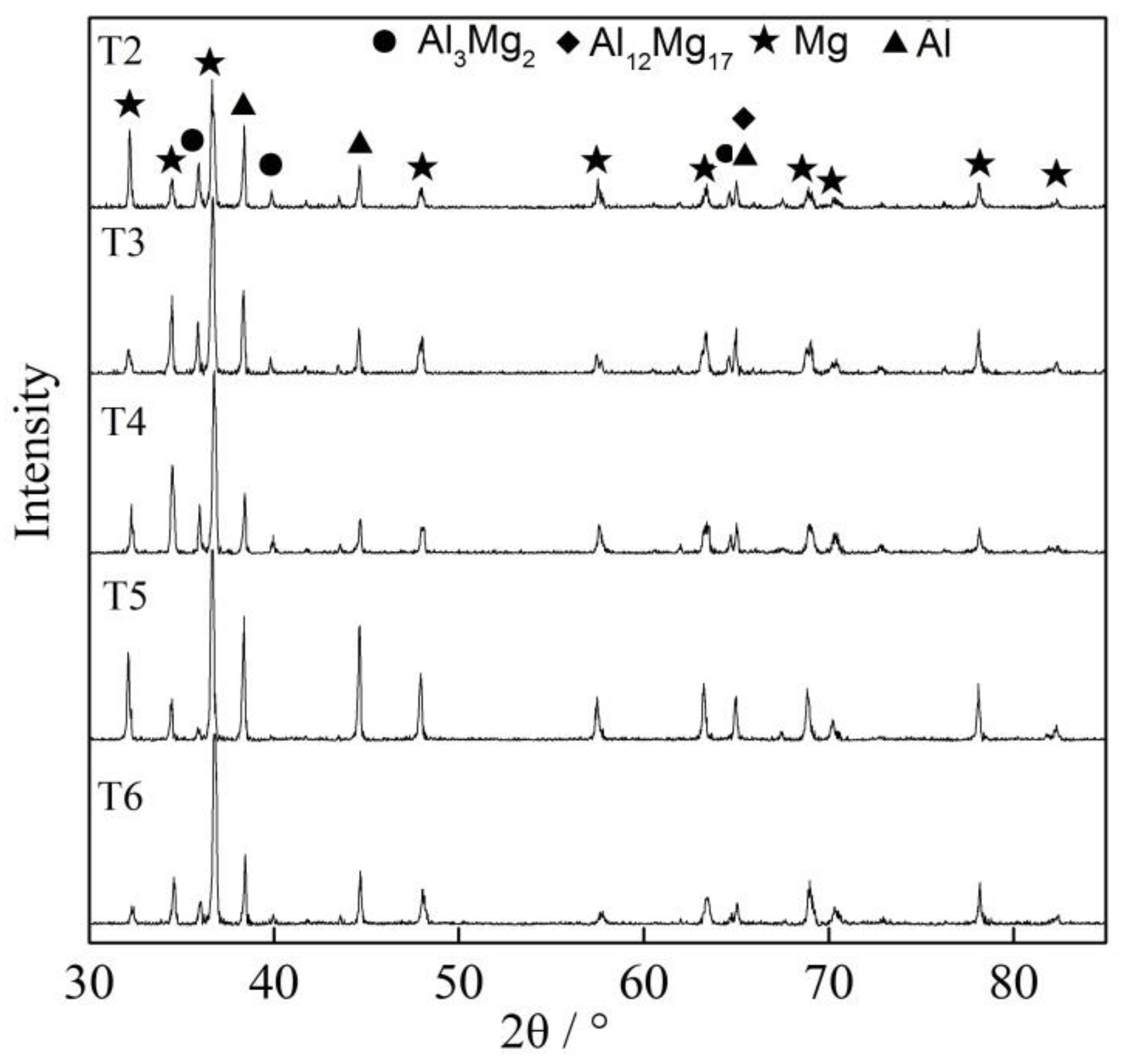
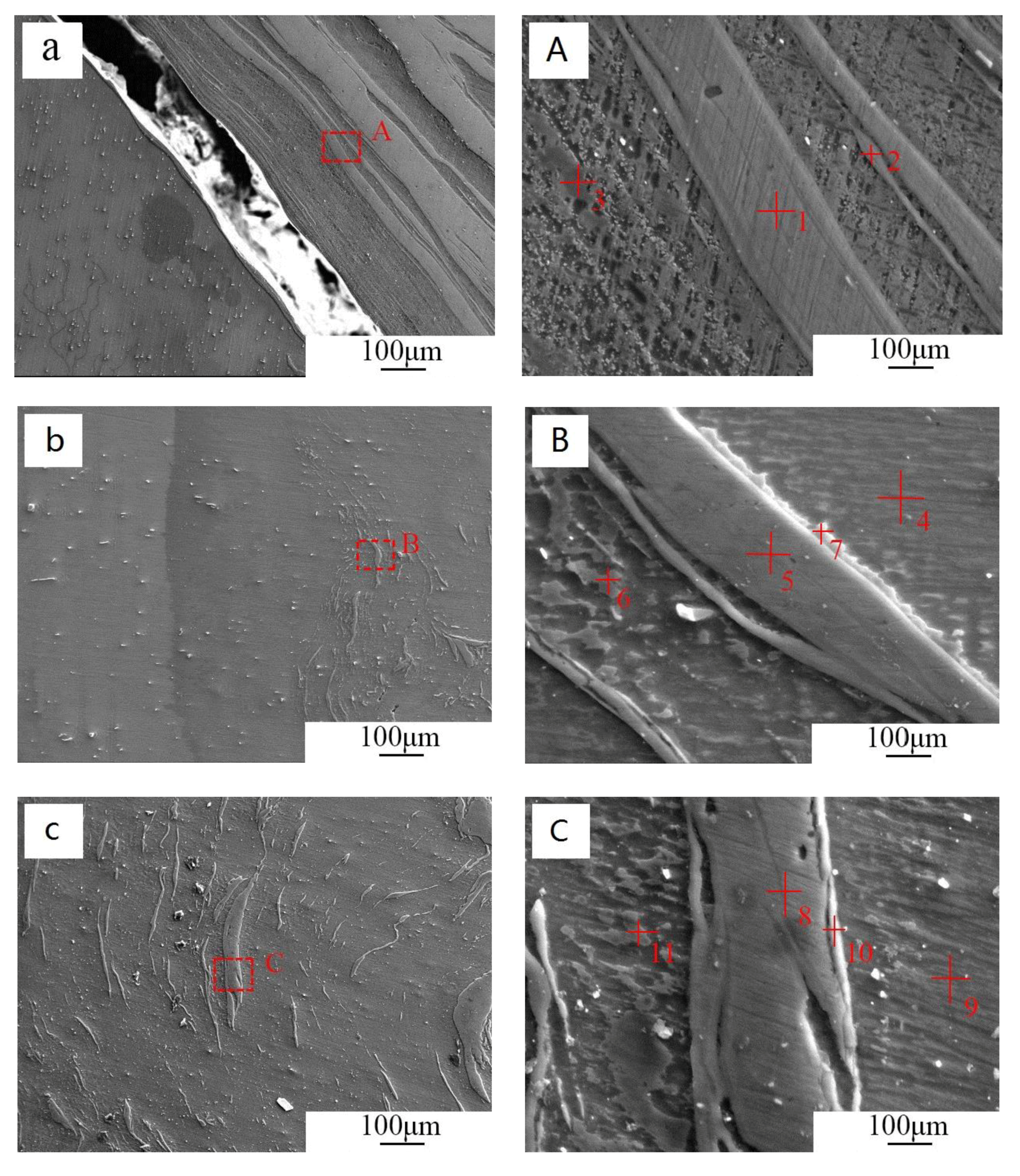
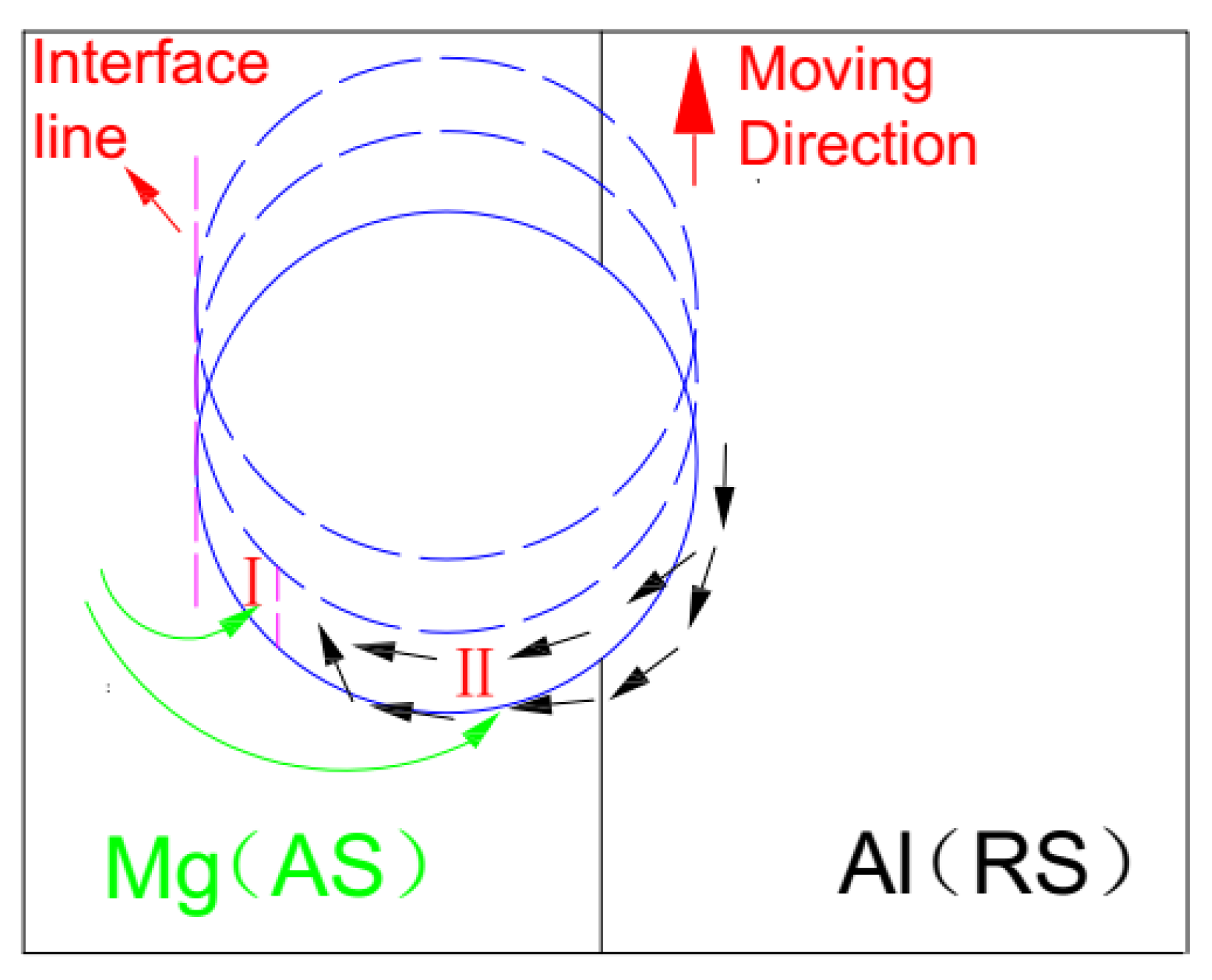
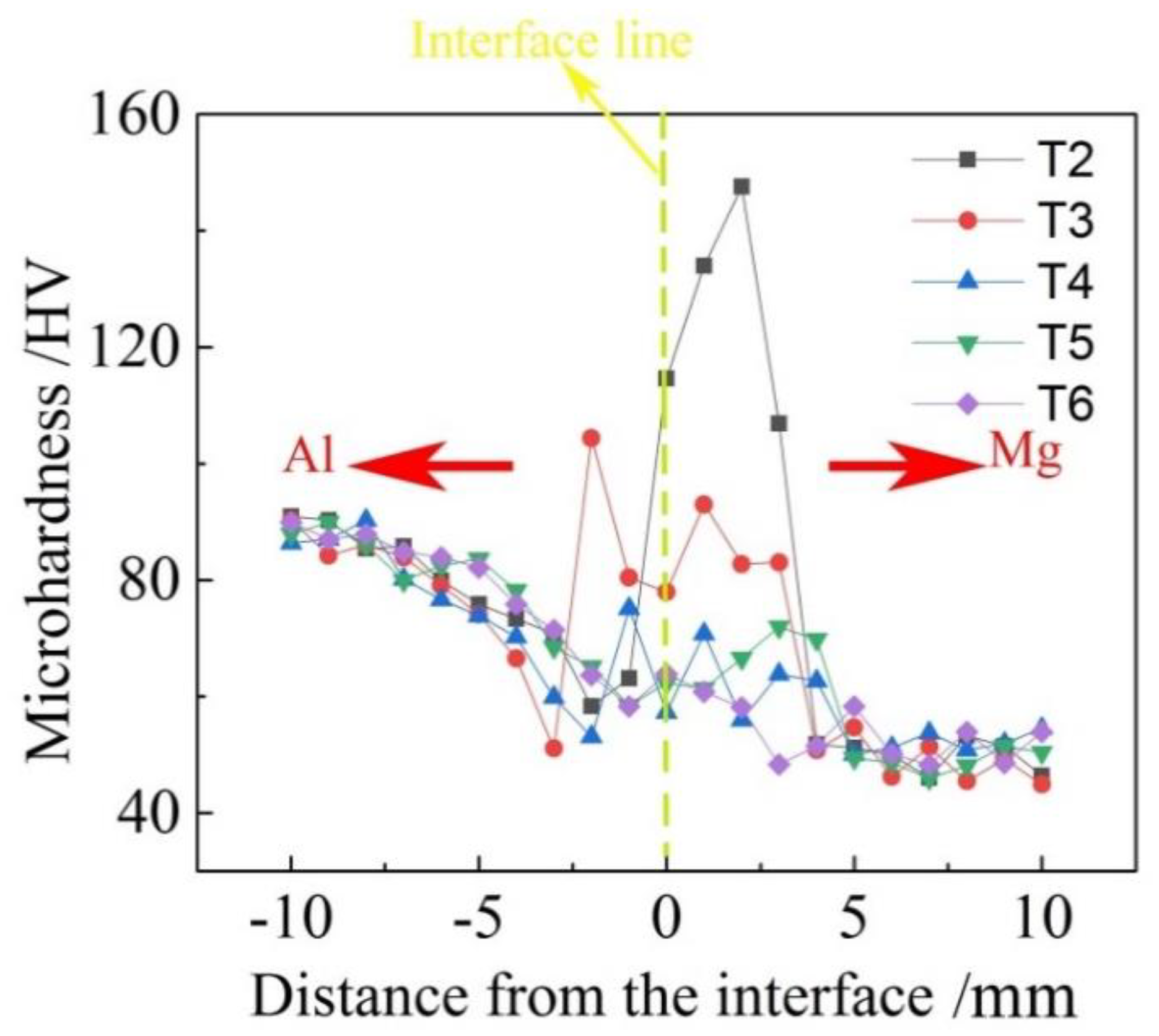

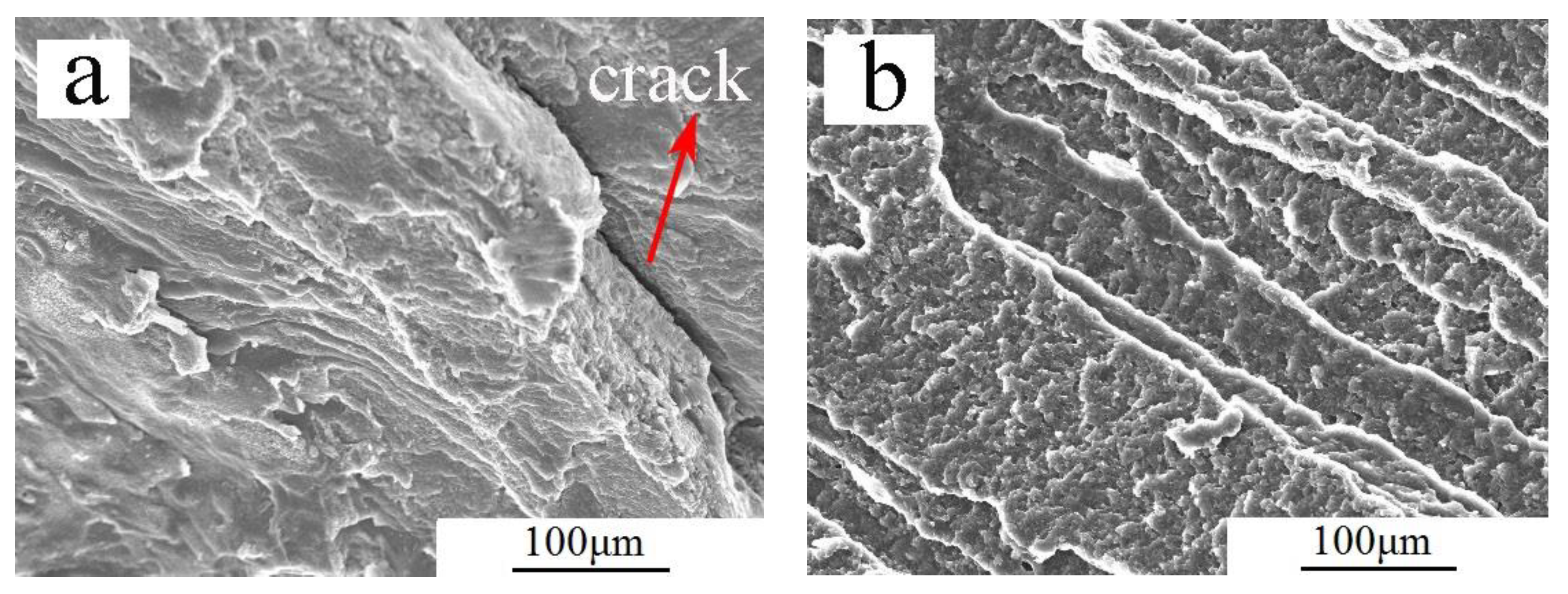
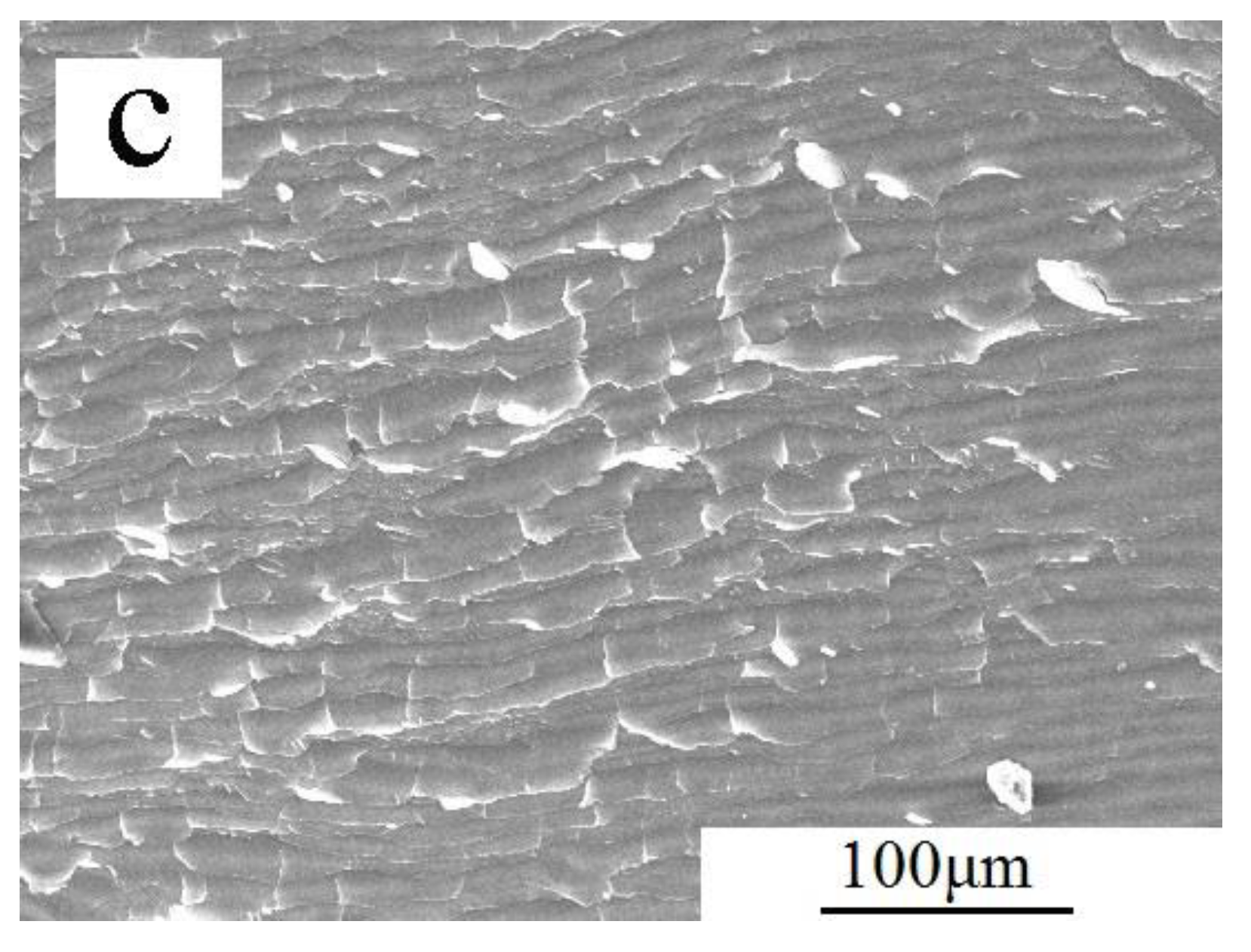
| Element | Si | Fe | Cu | Mn | Zn | Cr | Ni | Mg | Al |
|---|---|---|---|---|---|---|---|---|---|
| AA6061 | 0.537 | 0.28 | 0.12 | 0.16 | 0.11 | 0.17 | - | 0.56 | bal |
| AZ31B | 0.05 | 0.0022 | 0.0018 | 0.35 | 0.82 | - | 0.00016 | bal | 3.2 |
| Specimens | Rotation Speed (rpm) | Welding Speed (mm/min) | Material of AS | Tool Offset (mm) |
|---|---|---|---|---|
| T1 | 550 | 15 | Mg | 0.5 to Al |
| T2 | 0 | |||
| T3 | 0.5 to Mg | |||
| T4 | 1.0 to Mg | |||
| T5 | 1.5 to Mg | |||
| T6 | 2.0 to Mg | |||
| T7 | 2.5 to Mg |
| Points | Mg | Al | O | Si | Possible Phase |
|---|---|---|---|---|---|
| 1 | 2.53 | 96.08 | 0.86 | 0.52 | Al |
| 2 | 30.91 | 68.09 | 1.00 | 0 | Al + Al3Mg2 |
| 3 | 94.68 | 3.43 | 1.36 | 0.53 | Mg |
| 4 | 95.34 | 3.61 | 1.05 | 0 | Mg |
| 5 | 2.74 | 95.47 | 1.12 | 0.67 | Al |
| 6 | 59.79 | 39.46 | 0.74 | 0 | Mg + Al12Mg17 |
| 7 | 37.08 | 62.92 | 0 | 0 | Al + Al3Mg2 |
| 8 | 3.13 | 95.36 | 0.93 | 0.58 | Al |
| 9 | 95.34 | 3.61 | 1.05 | 0 | Mg |
| 10 | 28.33 | 70.74 | 0.93 | 0 | Al + Al3Mg2 |
| 11 | 61.67 | 37.52 | 0.81 | 0 | Mg + Al12Mg17 |
© 2020 by the authors. Licensee MDPI, Basel, Switzerland. This article is an open access article distributed under the terms and conditions of the Creative Commons Attribution (CC BY) license (http://creativecommons.org/licenses/by/4.0/).
Share and Cite
Liu, H.; Chen, Y.; Yao, Z.; Luo, F. Effect of Tool Offset on the Microstructure and Properties of AA6061/AZ31B Friction Stir Welding Joints. Metals 2020, 10, 546. https://doi.org/10.3390/met10040546
Liu H, Chen Y, Yao Z, Luo F. Effect of Tool Offset on the Microstructure and Properties of AA6061/AZ31B Friction Stir Welding Joints. Metals. 2020; 10(4):546. https://doi.org/10.3390/met10040546
Chicago/Turabian StyleLiu, Huachen, Yikun Chen, Zhenhua Yao, and Feixiang Luo. 2020. "Effect of Tool Offset on the Microstructure and Properties of AA6061/AZ31B Friction Stir Welding Joints" Metals 10, no. 4: 546. https://doi.org/10.3390/met10040546
APA StyleLiu, H., Chen, Y., Yao, Z., & Luo, F. (2020). Effect of Tool Offset on the Microstructure and Properties of AA6061/AZ31B Friction Stir Welding Joints. Metals, 10(4), 546. https://doi.org/10.3390/met10040546




